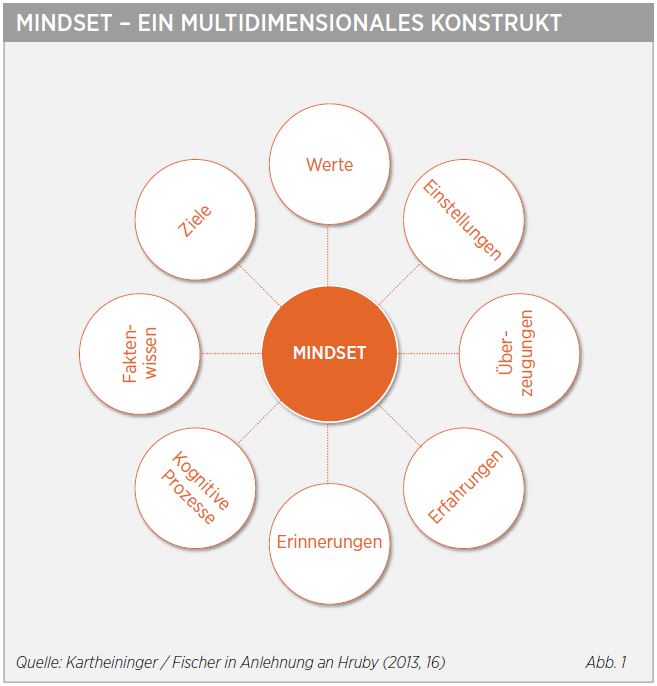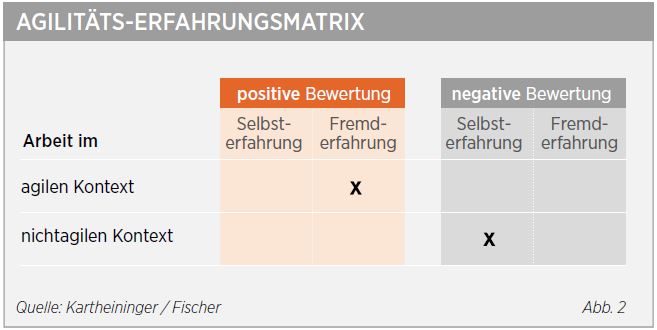Get in touch
Cordula Kartheininger studied Human Resources Management (M. Sc.) at the University of Applied Sciences, Pforzheim and in her Master's thesis she addressed the subject of the "Agile Mindset". In the following article, published in the Magazine Personalführung 04/2019, Cordula Kartheininger presents her findings from her Master's thesis, together with Professor Dr. Stephan Fischer, Director of the Institute for Human Resources Research at the University of Applied Sciences, Pforzheim and Dean of the Master's program "Human Resources Management".
Today, managers and employees are often expected to have an agile mindset or to develop one. But what exactly does an agile mindset mean? Cordula Kartheininger, HR Manager at AOE GmbH, and Professor Dr. Stephan Fischer of the University of Applied Sciences, Pforzheim, investigated this question. It turned out that an agile mindset is a multidimensional construct consisting of values, skills and outside experiences or self-awareness with regard to working in agile contexts. These dimensions must be taken into account when selecting and developing (agile) managers and employees.
Everyone is talking about agility as a form of adaptation to market and organizational changes. For some, the concept is becoming increasingly important due to current challenges (Weber / Zimmermann / Fischer 2018). For the others, in comparison, it is simply another sort of management hype that is sweeping across the country and producing nothing new (Kühl 2018). There is agreement that this is a well-known concept that is constantly gaining in relevance (Häusling / Fischer 2016).
Please enable English subtitles. Find the complete interview series with Prof. Fischer about agility, here.
In the relevant literature and in current research, three levels of agility can be distinguished (Fischer / Weber / Zimmermann 2017a):
The term "agile mindset" is often used as a prerequisite for the successful implementation of agility and is associated with desired or undesired ways of thinking and acting (Hofert 2018). What exactly an agile mindset is, however, remains mostly unclear. Below, we dare to attempt a conceptual definition.
PONS translate mindset as "a way of thinking" and the "way you think about something". The Oxford Dictionary defines mindset as an "established set of attitudes, esp. regarded as typical of a particular group's social or cultural values; the outlook, philosophy, or values of a person, frame of mind, attitude, disposition". This understanding illustrates the multidimensionality of Mindset, which is also shown in the following figure (Fig. 1).

But what is an "agile" mindset? In general, when fitting a person to an (agile) organisation, the aspects of personal ability (abilities, skills, competencies) as well as individual will (values, motivation) must be referred to (Rosenstiel 2015). The following content dimensions can be extracted from this:
Values play a key role in the mindset because of their action-guiding effect. Thus, individuals prefer to make decisions that are in line with their values (Bardi / Schwartz 2003). They also assess the behavior of others on the basis of their values (Klein 1991). In addition, values are a central element of personal and social identity and are relatively stable over time (Hitlin 2003).
The action-relevant influence of values grows in uncertain decision-making situations (Teufer 1999), which are frequently encountered in an agile environment. Which values are particularly relevant here? In the context of an empirical study (Kartheininger 2018), selected value types according to Schwartz (1994) were analyzed with regard to their relevance for employees of AOE GmbH, Wiesbaden.
AOE GmbH (n.d.) is an agile service provider for the development of digital solutions in the enterprise segment. The company, which employs 250 people at seven international locations, is described as a "pioneer among agile companies" (Wehner 2017) and a "star in agility" (Schoch 2016) due to its flat hierarchies or lack thereof as well as its self-organized teams.
The study of a total of 80 AOE employees showed that the value type "self-determination" and its underlying values freedom, creativity, independent choice of goals, autonomy and curiosity are particularly important within an agile context. In addition, collaboration and the associated values of trust, openness and respect are considered important by respondents. These "agile values" represent a promising indicator for the fit of successful employees with an agile organization.
Experience-based knowledge plays a central role in information processing and decision-making (Walsh 1995). Especially in an agile context, a key role for experience-based knowledge results from the high personal responsibility of employees and the necessity to make decisions in a constantly changing and complex world of information (VUKA).
At AOE GmbH, the experiences of employees with agility before joining the company were examined with regard to possible implications for personnel selection. Self-awareness (direct experiences) and external experiences (observation / narration of third parties) (Ashford / Fried 1988; Gioia / Manz 1985) were distinguished between the agile and non-agile context. In addition, the evaluation of these experiences (positive / negative) and its significance in terms of entry motivation were recorded.
At AOE GmbH, two types of experience are frequently encountered: the positively evaluated external experience of work in an agile context and the negatively evaluated self-awareness of work in a non-agile context (Kartheininger 2018). Accordingly, in connection with a person's wish to join an agile organization, one can speak of a "path-from-a-non-agile-organization-movement" as well as a "toward-an-agile-organization-movement" (Fig. 2). Moreover, the majority of respondents have no professional experience (self-awareness) in agile organizations.

The challenge for personnel selection in agile organizations is to identify suitable applicants despite their frequently lacking agile self-awareness. In this context, it seems reasonable to compare their negatively evaluated experiences in the non-agile context with regard to the framework conditions of the agile organization.
The third dimension of the agile mindset is the development and promotion of competencies that promise success in agile companies. Four agility competences (Zhang / Sharifi 2000) seem to be particularly relevant here:
Employees who have developed these competencies relevant to the individual have the appropriate skills and abilities to operate successfully in agile companies. Combined with the aforementioned values and the experiences reported by others as well as one's own self-awareness with regard to working in agile contexts, the multidimensional construct of an "agile mindset" emerges.
As a measure to promote the agile mindset, AOE implemented the so-called "Marketplace". The basic idea is for employees to discuss and organize internal appointments in a self-reliant and self-reflective manner. The Marketplace consists of an internal wiki page and a weekly meeting.
In the run-up to the meeting, all employees collect the current developments in job appointments (e.g. requirements / job offers, requests for team / project changes) on the Wiki page and discuss them duringin the meeting. All employees, individually or in teams, can submit requests (wishes / concerns regarding job changes) at any time. The following three questions serve as a basis for discussion:
The period between meetings serves as a "waiting period" and gives each employee the opportunity to express concerns or objections regarding decisions made.
The Marketplace creates a space for transparent discussions about internal vacancies and promotes the traceability of decisions as well as the personal responsibility of employees and teams. The questions presented serve to promote self-reflection by taking different aspects into account and to create a basis for discussion with regard to several applicants. In general, the Marketplace requires a high degree of agile maturity of all participants, since the decision-making process must take into account the needs of others as well as various other factors (e.g. skills / competencies, customer requirements) in addition to one's own.
The Marketplace is a practical example of a paradigm shift within HR. In the traditional world, HR develops programs, whereas in the agile world, framework conditions are provided for the promotion of agile mindsets. For HR, this results in a wide variety of starting points.
On the one hand, the development of corresponding value models can be worked on. These include values for the company and values for employees, which play an important role both in personnel selection and in personnel development. It is conceivable, for example, to use relevant value inventories within the framework of selection interviews or to offer the opportunity to reflect on and develop one's own values as a building block for personal self-development.
On the other hand, experience and experimentation spaces can be created for all employees, as most of them come from the non-agile world. They have not yet had any experience with this type of work. Therefore, opportunities for positive experiences with agile work should be created. This recommendation is consistent with the results of an empirical study in agile companies. This (also) shows that the start to more agility is to "just give it a try" (Fischer / Weber / Zimmermann 2017b).
Finally, attention can be paid to the selection and promotion of agile competencies. This can be reflected in the biography of applicants from agile companies in the personnel selection process. A corresponding simulation would be conceivable for other applicants. Personnel development is about the targeted promotion of appropriate skills.
Agile Mindset represents a multidimensional construct. Accordingly, it is necessary for a person's values, experiences and competencies to fit into an agile environment. In agile practice, this has implications for HR in terms of the selection and development of personnel, among other things.